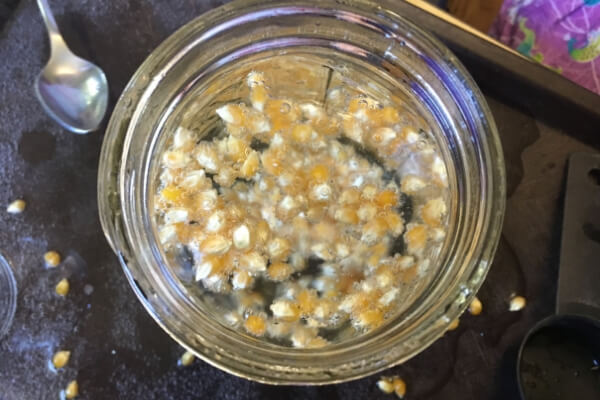In this article: Try this fun science activity with your kids and make some dancing popcorn!
Back 15 years ago when my oldest was about 3 years old, his absolute favorite activity was to make dancing popcorn. I recently resurrected the activity for my 3 year old (and my 8 year old, who was just as excited)
** This website contains affiliate links. If you make a purchase using one of these links, I may earn a commission. Please click here for more information about cookies collected and our privacy policy **.
For a kid, it almost seems like magic with popcorn kernels bouncing up and down dancing in water. But dancing popcorn is actually a great learning activity with lots of scientific principles at work.
Make your own dancing popcorn and have some good discussions about how it works with your kids!
How to Make Dancing Popcorn
Age levels: 2 and up
Supplies:
- 1 quart size jar
- water
- 1 T Popcorn kernels (or more)
- 2-4 T baking soda
- 1 cup white vinegar
- a spoon
Now that you have all your supplies, let’s get dancing!
Start by filling the quart jar about 3/4 full of water. I put all of my supplies on a tray to minimize any mess.
Have your kids add in the baking soda and stir well, until the baking soda has dissolved completely.
Now drop in the pop corn kernels. If your kids are anything like mine they will likely want more than 1 T…we probably added at least 1/4 cup of popcorn.
Now it’s time for fun!
Slowly pour in the vinegar, you may not need it all and if you pour too much too fast you will end up with a volcano-like eruption!
You will know you have added enough vinegar when the popcorn kernels begin to rise and fall.
Observe Your Dancing Popcorn!
My 3 year old was mesmerized by watching the popcorn go up and down and up and down. But he was also very observant, commenting on the bubbles that surrounded the kernels.
Here are some questions or things to discuss while watching your dancing popcorn:
Why is the popcorn going up? (the bubbles around the kernels are lifting them up)
Why does the popcorn sink when it gets to the top? (some of the bubbles pop when they reach the surface)
What is making the bubbles? (the carbon dioxide gas produced by the reaction of baking soda and vinegar)
You can also come up with other questions and hypothesize on the answers (and then give it a try). Things like:
- What will happen if you add more vinegar?
- What will happen if you add more baking soda?
- Can the bubbles support other items?
How Does Dancing Popcorn Work?
In case it’s been awhile since your last chemistry class, let’s talk about how this little experiment works.
Baking soda is a bicarbonate(or NaHCO3) and it’s a base. Vinegar is an acetic acid (or HCH3COO), which of course is an acid.
When these 2 combine a chemical reaction occurs. As a result of this chemical reaction, carbon dioxide gas is produced. (Here’s a more exact description of what happens during the reaction)
When this reaction happens under water the carbon dioxide gas is trapped in bubbles which then collect on the popcorn kernels.
When enough bubbles have collected the kernels begin to rise.
Remember in the movie UP! when they attach so many helium balloons to the house the house can fly? It’s similar to that.
But what happens when some of those balloons pop? The house starts to sink. The same is true for the popcorn.
When the bubbles reach the top of the jar and hit the air, the gas is released and they bubbles pop. Once a few bubbles have popped there’s no longer enough gas to support the popcorn and it begins to sink.
What makes it dance? The process repeats! As the kernel sinks, more bubbles start to collect again and it rises once more.
The popcorn will dance and dance until the reaction has released all of the carbon dioxide.
Want to make the experiment last longer? Just add more baking soda and vinegar!
Looking for more Baking Soda and Vinegar Activities? Check out the activities below:
7 Baking Soda and Vinegar Activities for Kids!
For More Science Fun Checkout These Articles:
Acid or Base Experiment for Kids
Learn About the Butterfly Life Cycle with Real Butterflies
Simple Chemical Reaction Experiment (That Gives Off Heat!)

How to Make Dancing Popcorn
Have fun learning chemistry with this fun dancing popcorn activity!
Materials
- water
- 1 T Popcorn kernels (or more)
- 2-4 T baking soda
- 1 cup white vinegar
Tools
- A quart glass jar
- a spoon
- plastic tray (optional)
Instructions
- Start by filling the quart jar about 3/4 full of water
- Add in the baking soda and stir well ( until the baking soda has dissolved completely)
- Add the pop corn kernels to the jar
- Slowly pour in the vinegar, you may not need it all and if you pour too much too fast you will end up with a volcano-like eruption!
- You will know you have added enough vinegar when the popcorn kernels begin to rise and fall.
- Observe and discuss!








This was so helpful!!!
My younger sister did this experiment as a presentation for her yr 2 class.
They loved it, thanks so much 😊